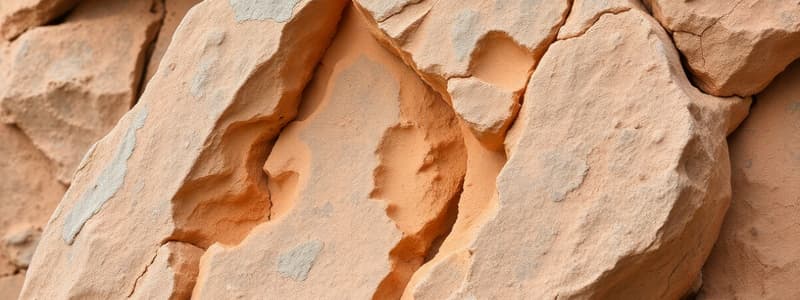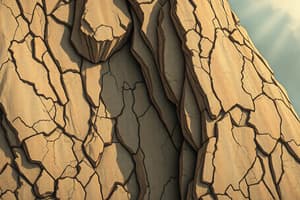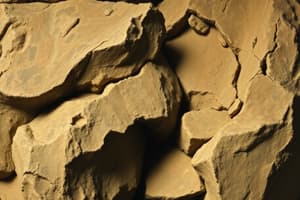Podcast
Questions and Answers
What does stress refer to in the context of geology?
What does stress refer to in the context of geology?
- The force exerted on a rock per unit area (correct)
- The temperature of surrounding materials
- The mineral composition of the rock
- The weight of rocks in a layer
Which type of stress results in the creation of ocean trenches and mountain ranges?
Which type of stress results in the creation of ocean trenches and mountain ranges?
- Volcanic stress
- Compressional stress (correct)
- Tensional stress
- Shear stress
What is a monocline?
What is a monocline?
- A flat layer of sedimentary rock
- An arch-like structural trap formed by folding
- A trough-like fold where the beds dip towards the center
- A step-like fold in rock strata (correct)
Which geological feature is primarily created by tensional stress?
Which geological feature is primarily created by tensional stress?
What defines plastic deformation in rocks?
What defines plastic deformation in rocks?
Shear stress results from which type of movement between rock blocks?
Shear stress results from which type of movement between rock blocks?
Which landforms are associated with compressional stress?
Which landforms are associated with compressional stress?
What happens to rocks when they experience elastic deformation?
What happens to rocks when they experience elastic deformation?
Flashcards are hidden until you start studying
Study Notes
Stress
- Stress is the force per unit area on a rock
- Stress causes changes in shape, deformation, or strain
- Stress depends on the type of rock and the surrounding temperature and pressure conditions
Deformation
- Strain is the rocks response to stress (deformation)
- Elastic deformation is reversible (rock returns to original shape)
- Plastic deformation is permanent (rock does not return to original shape)
Compressional Stress
- Squeezes rocks together
- Occurs at convergent plate boundaries (tectonic plates plowing into each other)
- Powerful earthquakes occur in these areas
- Chile: Nazca and South America plate
- Japan: Eurasian plate and Philippine plates
- Rocks deforming plastically can crumble into folds
- Creates Ocean Trenches and Mountain ranges
Three Types of Folding
- Monoclines are step-like folds in rock strata with a zone of steeper dip within an otherwise horizontal or gently dipping sequence.
- Anticlines are arch-like shaped folds formed by the folding of rock strata
- Synclines are trough-like folds with beds that dip towards the fold's central axis
Tensional Stress
- Extensional stress stretches and pulls rocks apart
- Occurs along divergent plate boundaries (tectonic plates tearing from one another)
- Creates Continental Rifts and Mid-ocean Ridges
Shear Stress
- Two blocks of rocks pushing in opposite directions causes rocks to slide against each other
- Results in faults and fault zones
Studying That Suits You
Use AI to generate personalized quizzes and flashcards to suit your learning preferences.




